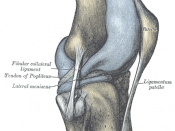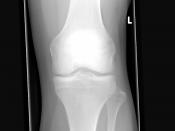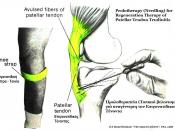* Patellar tendonitis (jumper's knee) is by far the most frequent reported overuse injury in volleyball accounting for 60-80%. Patellar tendonitis is the third most common injury in volleyball representing 4-24% of all volleyball related injuries. Patellar tendonitis would be one of the main injury problems for volleyballers because jumping is so integral to the sport. Furthermore, elite players spend much of their practice time doing jump training, which includes plyometrics to increase vertical jump height.
The usual symptoms are anterior knee pain when jumping and landing, dull aching pain after sports participation which can progress to constant pain during activity and at rest, and "point" tenderness at the site of the damage.
* Patellar tendonitis is a chronic injury in volleyball accounting for 72% of all chronic injuries associated with volleyball. Patellar tendonitis is a soft tissue injury because it's an injury that would not be easily observed by objective medical tests, but rather you would see the inflammation and pain shown by the injured person.
* In order to prevent patellar tendonitis the following needs to occur:
- Volleyball should be played on wooden floors (or synthetic floors with similar elastic properties). Playing on hard surfaces (for example concrete or lino) should be
avoided.
- Serious competitors should use cross training to limit the amount of training involving
repetitive stresses on the knees.
- Knee pads should be worn in training and match play to prevent acute knee injuries.
- Coaches should consider introducing balance board training, particularly for players with knee instability.
- A plyometric (jump training), stretching and strength training program should be
considered for all players to decrease peak landing forces.
- Players who are jumpers, middle blockers and players with knee pain are advised to decrease their jump training time and pay close attention...


